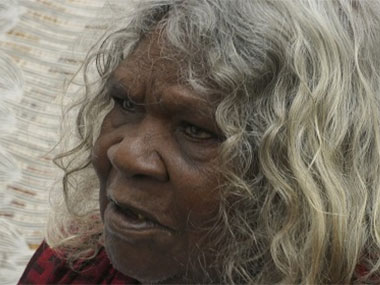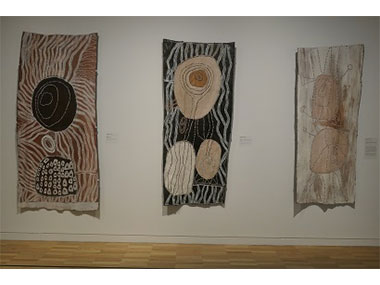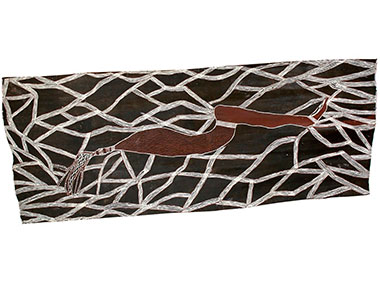NONGGIRRNGA

The artist during a discussion at the Cross-Arts Gallery in Sydney's Kings Cross associated with her AGNSW opening
Posted by Jeremy Eccles | 25.11.18
Gallery: Art Gallery of NSW
Dates:
03.11.18
: 24.02.19
In the catalogue for the excellent solo showing of artworks by Nonggirrnga Marawili at the Art Gallery of NSW there's a blissfully ordinary picture of the artist – barefoot below an ankle-length cerise skirt – resting on one of many rocks dotting the foreshore of a totally uneventful bay. Behind her, the sea of the Gulf of Carpentaria is almost unnaturally calm. Not a wave in sight.
Yet this setting is Baratjala, where, as Elina Spilia recognises in the catalogue for the Scholl Collection of Aboriginal women's art currently touring the USA, when Nonggirrnga puts paint to bark or larrakitj pole in that setting you'll experience “Seaspray crashing on rock, the dance of flames, the flicker of the snake's tongue and lightning flashing across the sky – the elemental substances and transformative forces of the Yolngu world”.
The exhibition - entitled 'From my heart and mind' - makes it clear that this wasn't an overnight achievement for the now-79 year old woman. Which can be partly explained by her childhood in an extraordinary family in which their father Mundukul Marawili, a famed warrior who had “uncountable wives”, according to Will Stubbs, the long-term art coordinator at the artist's Buku Larrnggay art centre in North East Arnhemland, creating a family group that was 50-strong. They lived nomadically, moving on land and on the waters of the Gulf by canoe as food sources, ceremonial responsibilities and climate demanded. In all three circumstances, Nonggirrnga experienced the Madarrpa clan estates and sacred sites that would become the subject of her later artworks. But Mundukul died in 1950 when she was just 11, so was unable to pass on to her permission to paint those Madarrpa clan designs.
As a result, she had to work out how to paint the things that mattered deeply to her without offending against strict Yolngu protocols about who could reproduce which clan's sacred stories and symbols.
She began by assisting her husband Djutadjuta Mununggurr with his art, in 1994 working on a two metre bark of 'Mana' The Sacred Shark' which required a mass of cross-hatching and outlining by her which AGNSW curator Cara Pinchbeck notes gave “depth and movement to the sacred waters in this work”. By 1996, she was collaborating with their daughters Rerrkiwanga and Marrnayula on an even larger, three metre bark. In 1997, Djutadjuta would take out Best Bark at that year's NATSIA Awards. And Rerrkiwanga won Best Bark in 2009. But it would take until 2015 before the judges in Darwin would recognise the unpredictable talents of Nonggirrnga.
For, as that 1994 bark and solo works like the mythical fish trap at 'Wanduwuy' from 2012 reveal, she was not an artist who attempted to achieve neat perfection with her markings, but perhaps did more to reflect the realities of nature in patterns that experts compare to Nonggirrnga's father-in-law, Wonggu Mununggurr, a major contributor to the legendary drawings commissioned in 1947 by the anthropologists, Ronald and Catherine Berndt and sown by the AGNSW half a dozen years ago.
But it's the year 2012 that the exhibition features most heavily with a radical advance by Nonggirrnga from figurative work and overall patterning to much greater visual variety, the emergence of her trademark diamonds and the discovery that she could reflect Madarrpa stories without using the officially coded ways of doing that.
Her sensitivity to water lead Nonggirrnga naturally downstream from Wandawuy to Yathikpa, a point of land in Blue Mud Bay and the heart of Madarrpa clan culture. It's here the fresh meets the salt water, it's from here that Baralt'ja the sacred rock that stands strong against the forces of the sea and storm can be seen, it's on that rock that Mundukul the Lightning Snake senses the arrival of fresh, monsoonal waters from inland and fires off his electric curses into the sky in the form of lightning, and it's at the base of that rock that Baru, the sacred crocodile dived though the fire continued to burn on his back beneath the water. The waving sea-grasses reflect that fire today.
And so do Nonggirrnga's barks through until 2016, mainly in her trademark black and white. I have to wonder whether the Art Gallery's intention to feature her in this solo show may have contributed to her later efforts to 'brighten up' her works with some surprising reds and pinks, and the arrival of the roundish rocks from Baratjala in her work. Somehow, they sit uneasily upon the explosive lightness of her clashing seas and flashing lightning.
Of course, this all recognises the artist in Nonggirrnga, which is all-too-often denied in classical Aboriginal art. Her individual voice is apparent throughout. And all-power to the AGNSW and curator Cara Pinchbeck for acknowledging that voice in Indigenous art. The Gallery is also to be congratulated on placing this exhibition in the context of a solo show for Tony Tuckson, who did so much to introduce the ignorant south of this continent to the cultures of the north through Aboriginal art as art, not anthropology. On Nonggirrnga's other wing is a display of Melanesian art, another culture that Tuckson, as curator, introduced to the AGNSW.
All this bodes well for the Gallery's stated intention to use the entrance galleries to its controversial new Sydney Modern structure to show Aboriginal art – lifting it from the basement where the Yiribana Gallery has been confined for too long.
URL: https://www.artgallery.nsw.gov.au/exhibitions/nonggirrnga-marawili/
Share this:
»  del.icio.us
»
del.icio.us
»  Digg it
»
Digg it
»  reddit
»
reddit
»  Google
»
Google
»  StumbleUpon
»
StumbleUpon
»  Technorati
»
Technorati
»  Facebook
Facebook
Contact Details
Gallery: Art Gallery of NSW
Contact: Cara Pinchbeck - Curator of Aboriginal and Torres Strait Islander Art
Email: artmail@ag.nsw.gov.au
Telephone: +61 2 9225 1700 or 1
Address: Art Gallery Road Sydney Sydney 2000 NSW
Gallery: Art Gallery of NSW
Contact: Cara Pinchbeck - Curator of Aboriginal and Torres Strait Islander Art
Email: artmail@ag.nsw.gov.au
Telephone: +61 2 9225 1700 or 1
Address: Art Gallery Road Sydney Sydney 2000 NSW

A triptych of Nonggirrnga's recent paintings from Baratjala in the current AGNSW solo show

'Mundukul' (2014), the Lightning Snake of Mandarrpa legend, after whom her prolific father was named
Where is the exhibition?
Further Research
Gallery: Art Gallery of NSW
Artists: Djutadjuta Mununggurr | Marrnayula Mununggurr | Mundukul Marawili | Nonggirrnga Marawili | Rerrkiwanga Mununggurr | Wonggu Mununggurr
News Tags: AGNSW | Blue Mud Bay | Buku Larrnggay | Cara Pinchbeck | Jeremy Eccles | Sydney Modern | Tony Tuckson | Will Stubbs
News Categories: Australia | Blog | Exhibition | Feature | Industry | News
Exhibition Archive
- 25.11.18 | NONGGIRRNGA
- 13.11.18 | The Uluru Statement comes to Sydney
- 05.11.18 | Skye's the Limit
- 29.10.18 | MAJOR INDIGENOUS COMMISSION FOR THE ASIAN STAGE
- 17.10.18 | Tommy Watson in Sydney
- 10.10.18 | The Aboriginal Memorial – A Smouldering Reproach
- 03.10.18 | Closing the Craft Circle
- 03.10.18 | Quilliam's Blood, Bone, Ascension
- 13.09.18 | SYDNEY CONTEMPORARY 2018
- 03.09.18 | Mawurndjul Makes Headlines in DC
- 23.08.18 | Indigenous Pots Are Hot
- 19.08.18 | CIAF Sets Records
- 16.08.18 | The Politics of Art in Darwin
- 01.08.18 | A SENSE OF PLACE
- 29.06.18 | INTERNATIONAL ACTIVITY
Advertising

